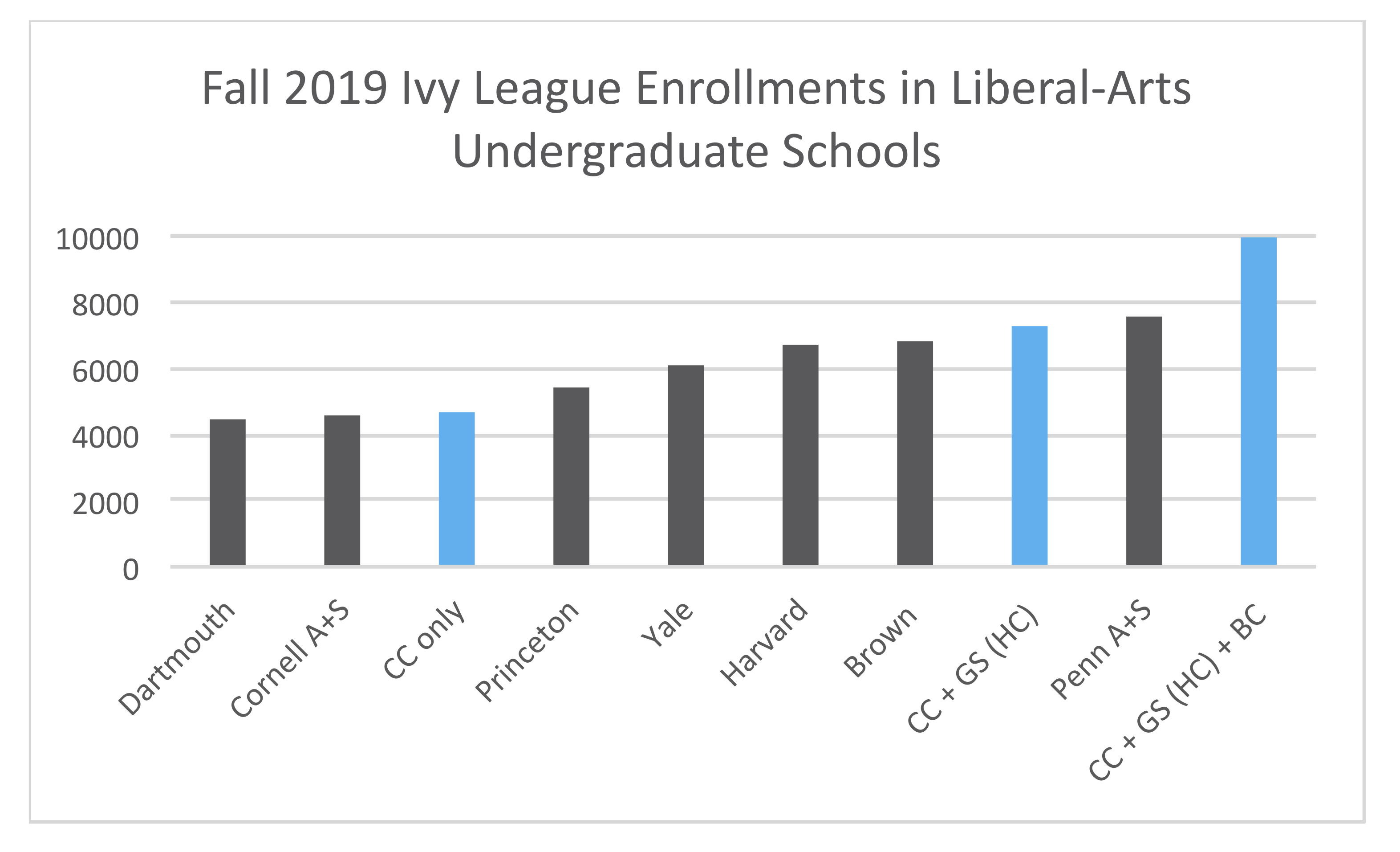
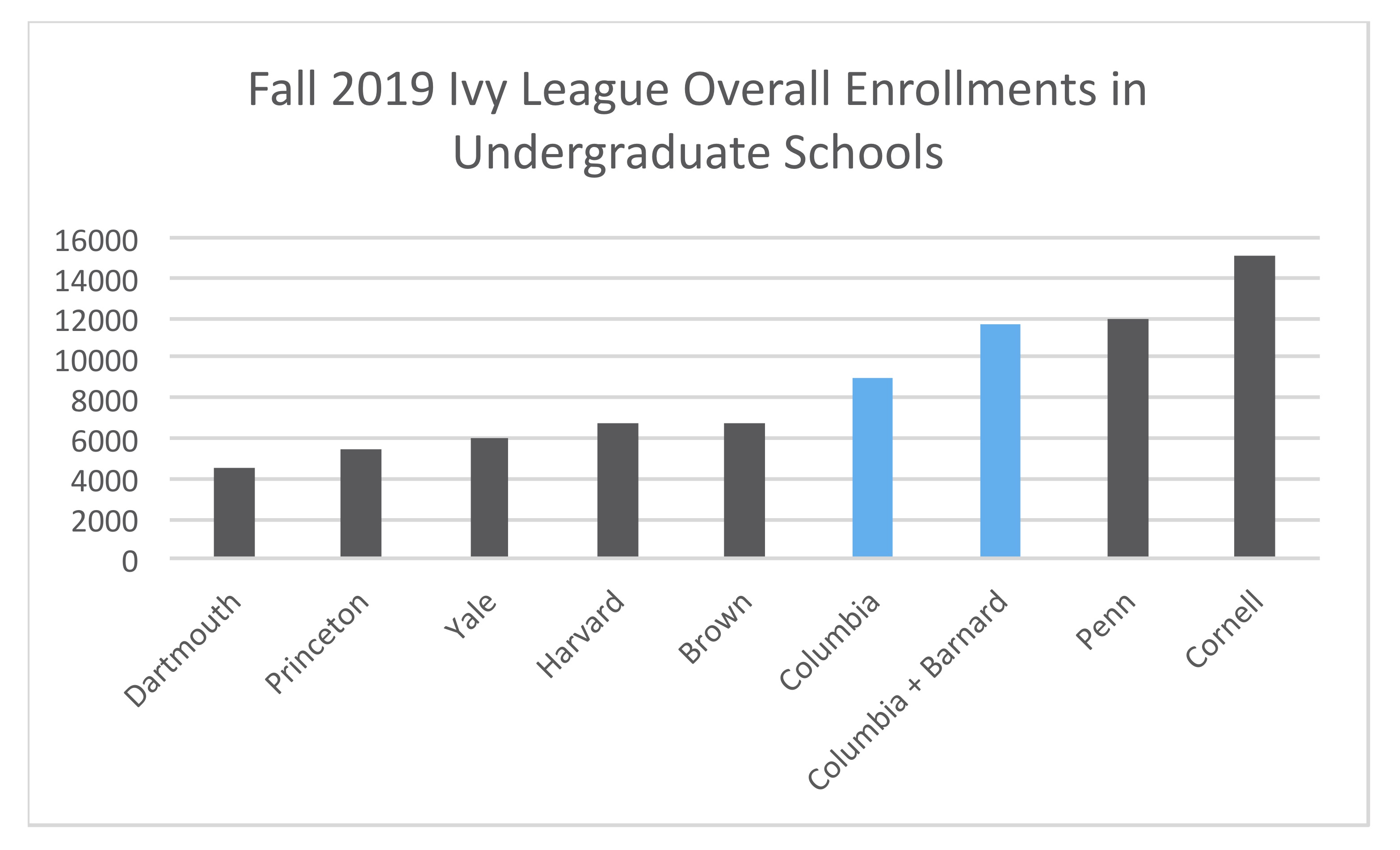
Michael Thaddeus
Professor of Mathematics
mt324@columbia.edu
March 2021
We have to have growth as the institution evolves. We need new buildings because we have to add faculty and students. That is the history of great institutions. As we generate more knowledge, that knowledge becomes more complex. We need to have more people contributing to these efforts and making use of the insights that result.
Growth entails some risks, of course. For example, we don't want to lose a sense of community. But to grow at the right kind of pace is desirable, and that is what Columbia has been doing. Nearly every part of the University is bigger than it was a few years ago.
Today, Columbia is already one of the larger Ivy League undergraduate schools. To be sure, Columbia College is relatively small: with about 4,500 undergraduates, it is not much larger than Dartmouth, the smallest Ivy. Yet Columbia is one of only three Ivies to have several undergraduate colleges, and it is unique in having several undergraduate colleges in the liberal arts alone. Counting Columbia College and General Studies, Columbia has about 7,000 liberal-arts undergraduates (see Figure 1). Counting Barnard as well, this figure rises to more than 9,500 liberal-arts undergraduates — the most in the Ivy League. Finally, with SEAS included too, Columbia/Barnard has a grand total of nearly 12,000 undergraduates overall, about the same as Penn and decisively surpassed in the Ivy League only by Cornell (see Figure 2).
 |
 |
Columbia's undergraduate enrollments have grown dramatically over the last two decades. The total undergraduate headcount enrollment in the three Columbia schools (CC, GS, SEAS, excluding Barnard) grew by a whopping 30% from 2002 to 2019, vastly exceeding the growth of any other Ivy undergraduate student body (see Figure 3). If we consider the period from 2002 to 2020 instead, the picture is similar, except that some of our peers actually shrank because of the pandemic (see Figure 4).
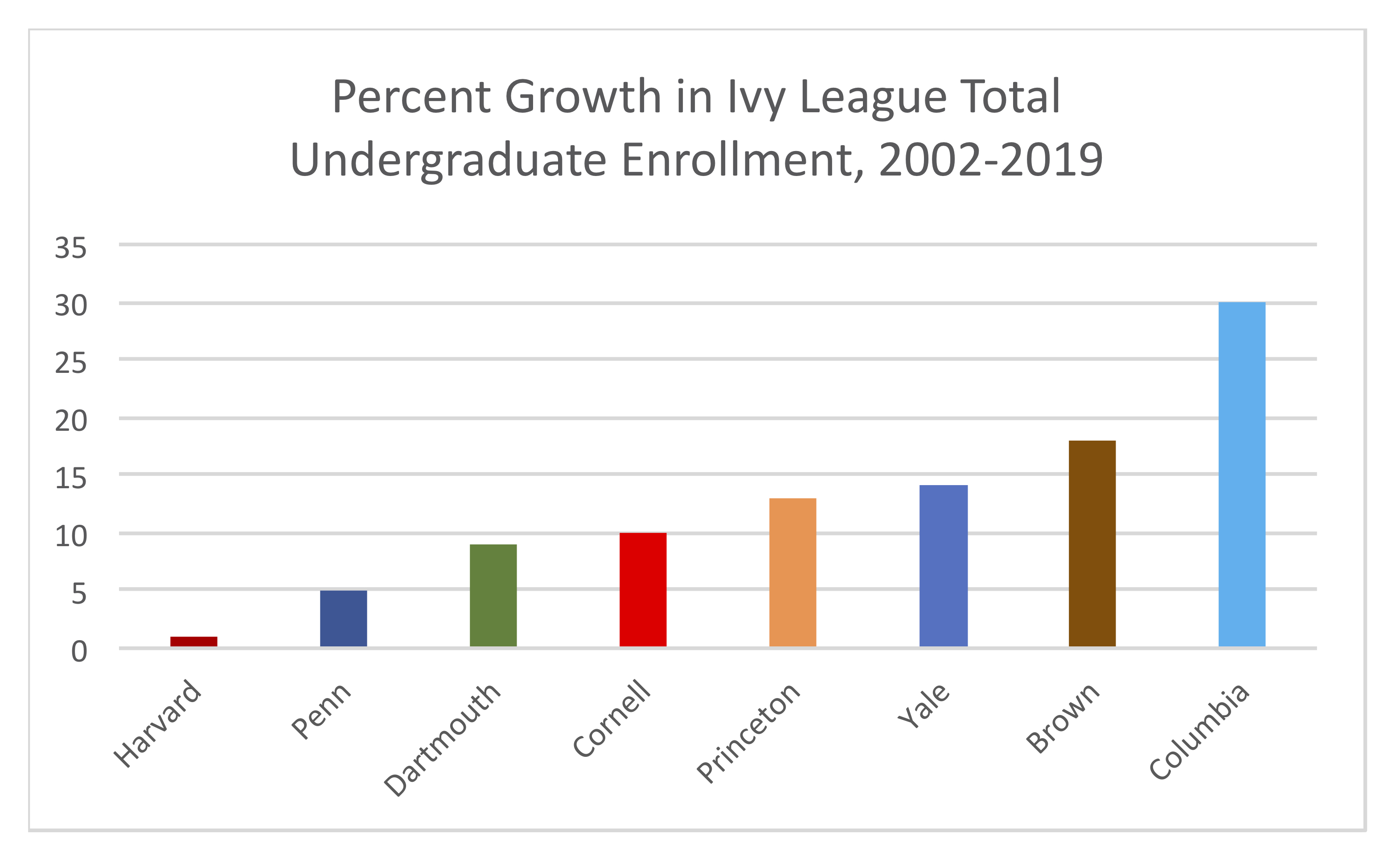 |
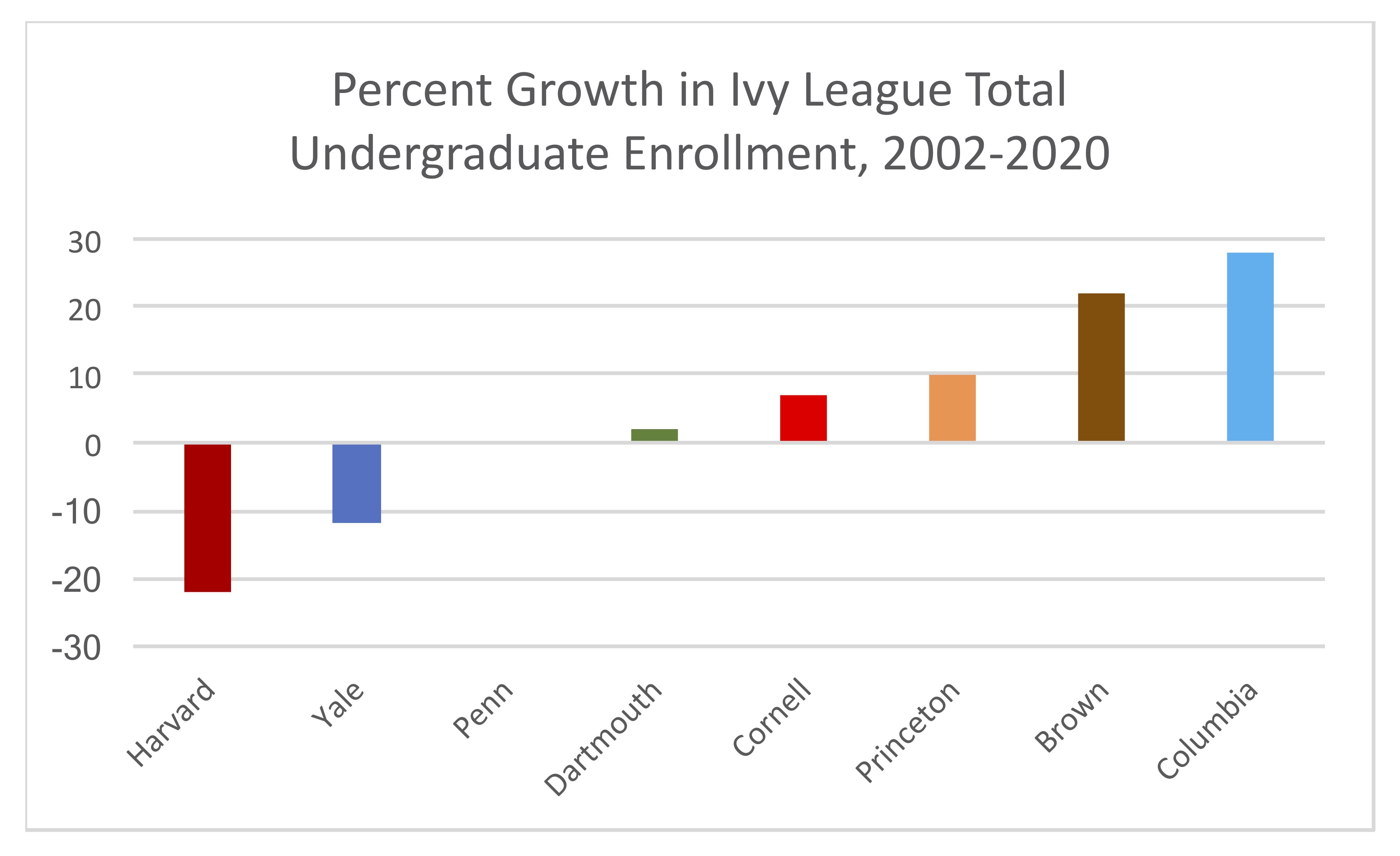 |
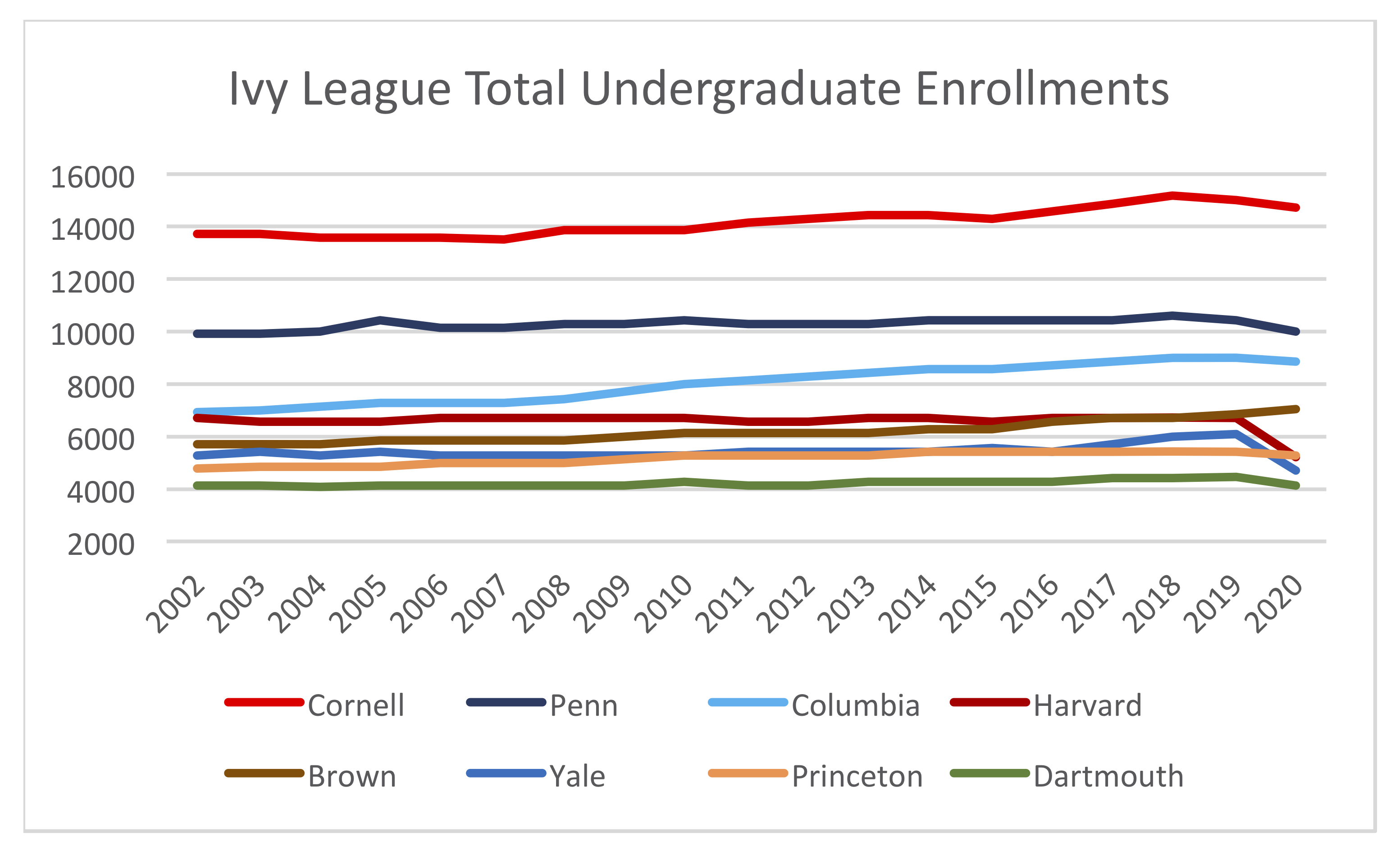 |
The primary driver of this growth has been General Studies, not Columbia College. Expanding CC requires the creation of new residential housing, which involves a concerted effort. Expanding GS, by contrast, requires no immediate commitment of physical resources. Consequently, while CC has grown only by fits and starts, GS has been able to grow steadily and rapidly over many years, at an average of 3.4% per year from 2002 to 2019 (see Figure 6). Since more and more GS students are full-time, the number of full-time equivalents grew even faster, at an average of 4.9% per year during that period. The overall growth in GS full-time equivalents from 2002 to 2019 was an amazing 125%. Even the growth in GS headcounts was 75%, dwarfing that of any other Ivy League undergraduate college (see Figure 7). The relentless growth of GS has occurred with little input, or even notice, from the faculty. One might say it has gone under the radar.
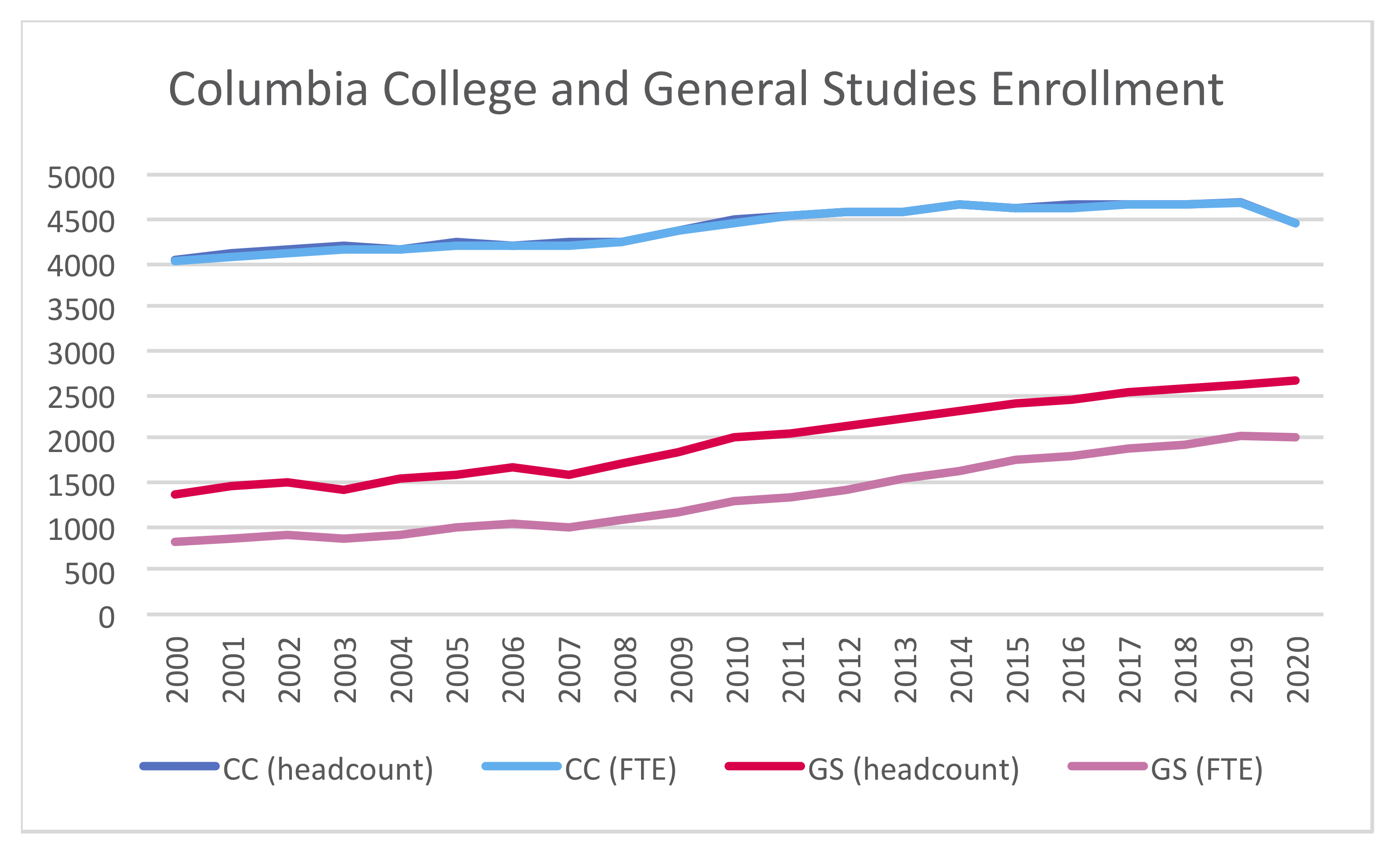 |
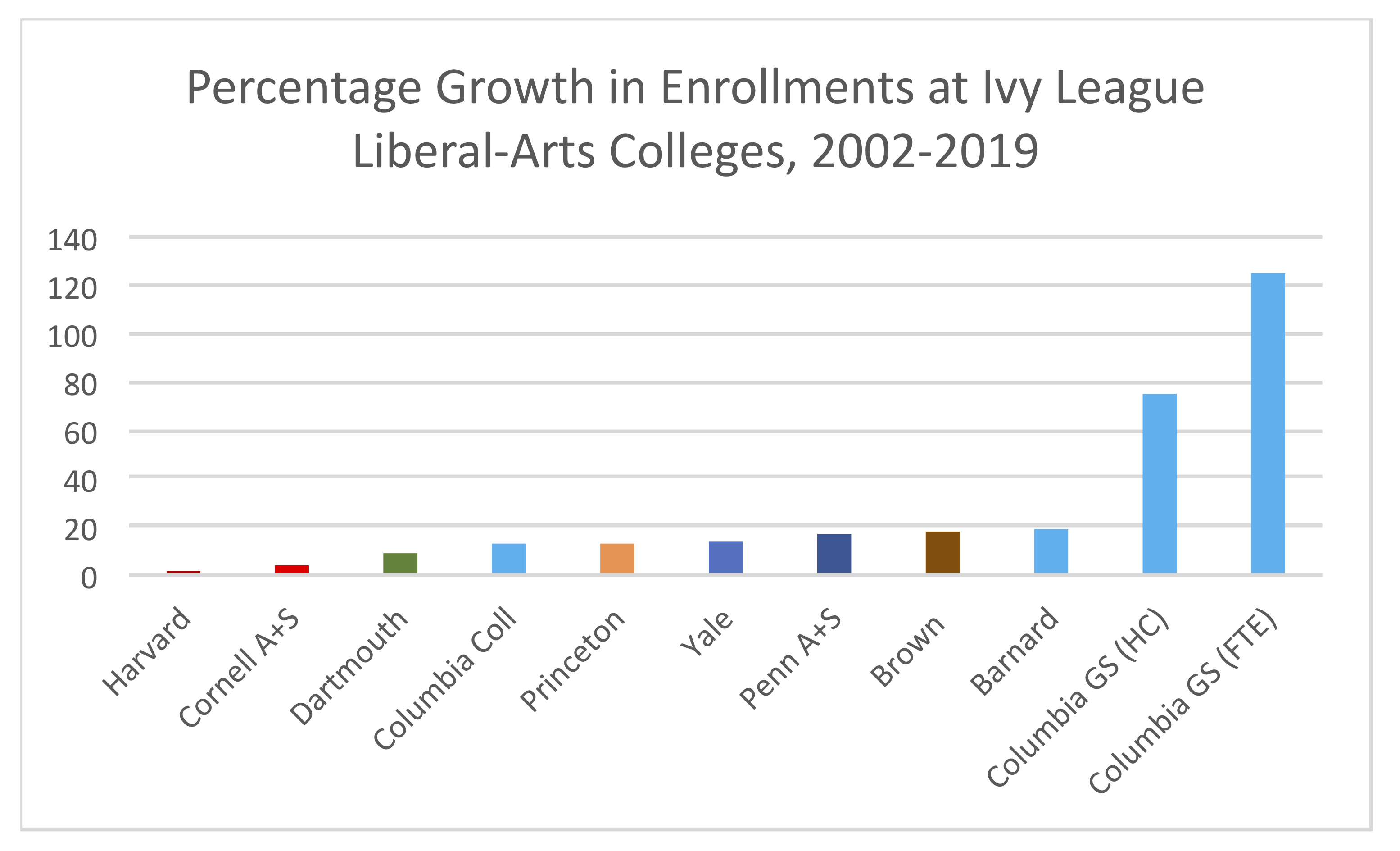 |
The growth of Professional Studies has further augmented our undergraduate class sizes. This is hard to quantify, since over 3,000 SPS students (not counted above) are scattered widely, many in summer courses and all-SPS master's programs. What's certain is that the overall headcount in SPS (formerly Continuing Education) has grown prodigiously, by 70% between 2002 and 2019, and that a lot of these students take undergraduate courses. It's important to realize that we teach large numbers of non-degree students side by side with full-time undergraduates, in the very same classes. This sets us apart from most of our peers. Yale and Princeton admit non-degree students, but in vanishingly small numbers; Harvard has a sizable Extension School, but its classes and faculty are completely separate from those of Harvard College.
Nevertheless, Columbia College has grown as well, undergoing two significant expansions in recent years. Enlargement and Enhancement in 1997-2003 was, according to Spectator, "the gradual enlarging of the College by nearly 15 percent over six years...while simultaneously reducing the size of graduate programs in the Arts and Sciences." Alfred Lerner Hall and Broadway Residence Hall — a student center and a dormitory — date from that era, but no new academic buildings were built, and virtually no new classroom space was created. Another Spectator story summed up student disaffection with the resulting overcrowding in a headline: "Students and Enlargement: Enhancement Not in Sight".
A few years later, during the Great Recession in 2009, An Agenda for the Future, a report issued by the Task Force on Undergraduate Education, recommended "a carefully planned and long-term expansion of Columbia College of approximately 15 to 20 percent," to be accompanied by creation of "additional dormitory, dining, classroom, athletic, and study space," as well as "faculty growth." What actually ensued over the next five years was a less ambitious expansion of Columbia College, by about 6%. Not surprisingly in light of the financial crisis, there were no improvements whatsoever to the physical facilities serving faculty and students, which remain shabby and severely overcrowded today.
A perennial theme of life at Columbia is that ceaseless growth in student numbers has not been matched by any growth or improvement in physical facilities. At least regarding the Morningside campus, President Bollinger's statement, quoted above, is half-true. We have added students and faculty, but we have built almost no new buildings, nor have we taken proper care of the old ones. Our campus is bursting at the seams.
The gymnasium is a paradigm of the inadequacy of campus facilities. The University Hall gym was a state-of-the-art amenity when it opened in 1897 (see historic photographs here and here). It was already outmoded in 1968, when the University made its ill-fated attempt to replace it with a gym in Morningside Park. There has since been no effort to make new provisions for recreational athletics, and the Dodge Physical Fitness Center, as the gym has been known since a 1974 renovation added some varsity facilities, remains the only recreational athletic space on campus as of 2021. It is a sturdy and beautiful structure, but it is poorly maintained and poorly adapted for present needs. It is also acutely overcrowded, as it serves a population that has grown at least tenfold since 1897.
The shortage of classroom space is an emergency situation. Of course, athletic facilities can be considered a luxury, but the same cannot be said of classrooms. Here the situation is desperate. A comparable shortage would be regarded as a crisis elsewhere, yet at Columbia it has persisted, and worsened, for decade after decade.
The number of seats in Registrar-managed classrooms on Morningside appears to have grown by only 9% in the last twenty years (with the addition of a handful of rooms in Chandler, Knox, and Northwest Corner), even as, between 2002 and 2019, the total number of undergraduates soared by 30%, and the overall number of all Morningside students skyrocketed even further, by 42%. The shortage of classrooms seating more than 40 students is particularly acute: to the best of my knowledge, only two Registrar-managed classrooms of that size (Chandler 402 and Northwest 501) have been created in decades. Anyone who has tried to reserve a classroom on a weekday afternoon for an extracurricular event, such as a distinguished lecture, knows that at Columbia this is well-nigh impossible.
During the last major round of expansion, starting with the Fall 2012 semester, one additional weekday class period was eked out by moving the first period back to 8:40 a.m. and eliminating the lunch hour. Ever since, students have tended to bring their lunch into the lecture hall and eat it during class. The point is that, where classroom space is concerned, the potential efficiencies have already been exploited. There are no corners left to cut.
The existing classrooms in Uris Hall will be urgently needed to mitigate the crisis, as soon as they become available to Arts & Sciences. Even they probably will not be enough.
Meanwhile, faculty numbers have struggled to keep pace with student growth. Between 2002 and 2019, the number of full-time Arts & Sciences faculty (excluding Arts, SIPA, and SPS) grew by 47%, outpacing the growth in full-time equivalents of Arts & Sciences undergraduates (that is, CC and GS), which was 34%. As a result, the A&S student-faculty ratio fell from 8.4 in 2002 to 7.6 in 2019, a notable improvement (see Figure 8). This is not the whole story, however, as progress has been far from steady since 2002. In fact, the entire improvement in student-faculty ratios occurred in the five years before 2007, when there seems to have been a serious effort to expand the faculty in the wake of Enlargement and Enhancement. After the financial crisis, by contrast, the student body was enlarged while faculty size stagnated. This has led to significant backsliding in the student-faculty ratio from its low of 7.1, achieved in 2007.
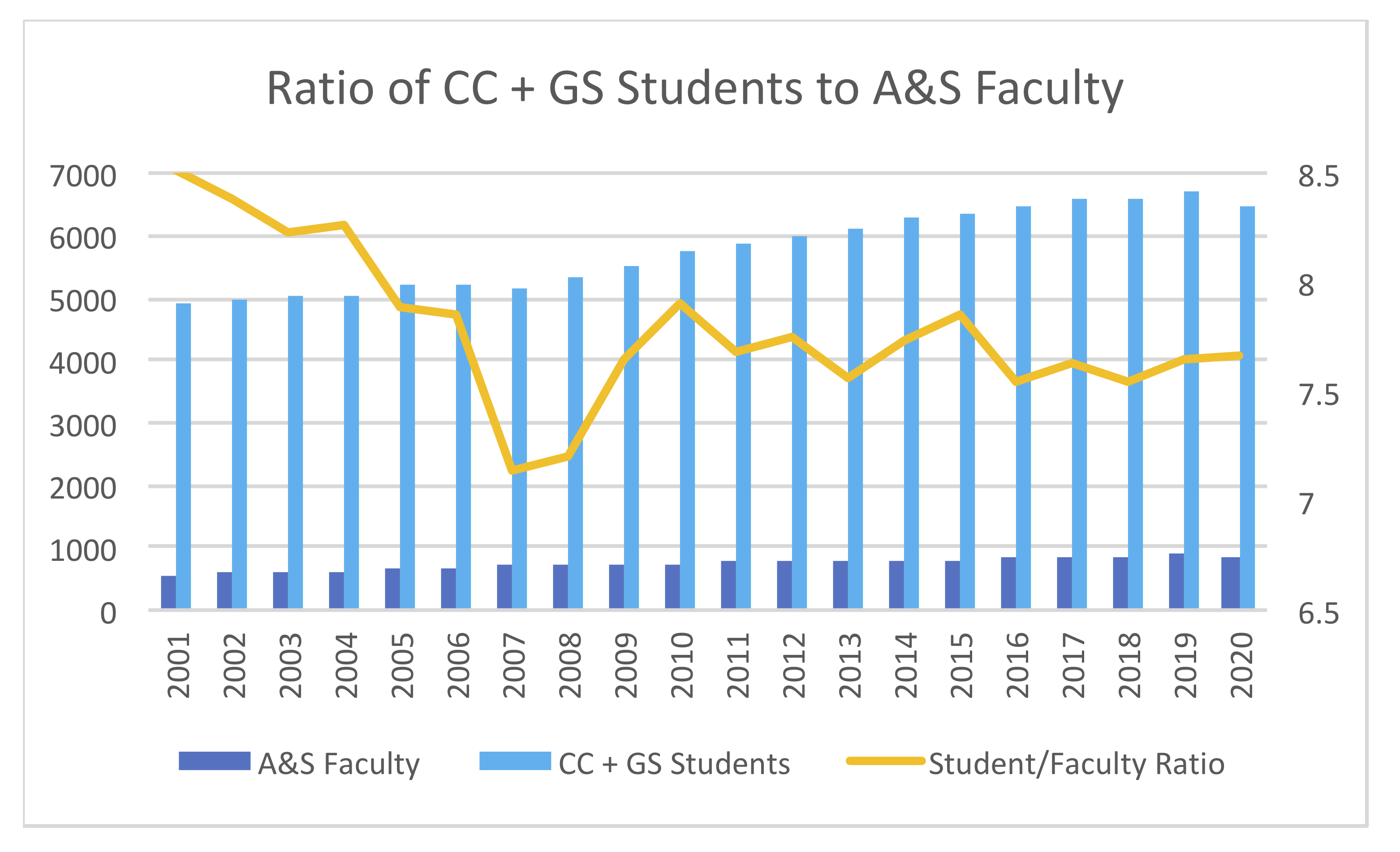 |
It has been pointed out that, when A&S graduate students are counted as well, student-faculty ratios have fallen considerably during the pandemic. However, this chiefly reflects drastic declines in the numbers of overseas students in free-standing master's programs, which are taught by a small number of faculty. While this is, of course, significant for our fiscal position, its academic effects are largely confined to the faculty and students in these programs.
The most prestigious institutions do not use undergraduate growth as a tool to produce revenue. They understand that intelligent growth requires massive investment, both in faculty and in infrastructure, and is therefore almost revenue-neutral. Harvard College has grown hardly at all in half a century. Princeton's undergraduate numbers have risen, gradually and cautiously, by about 13% since 2002, even as the ranks of tenure-track faculty grew by 20%. After decades with no growth to speak of, Yale College embarked in 2014 on an ambitious project to expand enrollment by 15%, but only after a $250 million gift, and a fund drive for twice that amount, enabled it to build two whole new residential colleges. Yale Provost Ben Polak told the Washington Post, "At no point in the expansion did we think we'd do it to raise money for the university. This is about access."
It is tempting to insist that any expansion plan come with an ironclad commitment to investing in our physical surroundings and in our faculty. Yet this is exactly the promise that was dangled by the Task Force on Undergraduate Education in 2007. What we got instead was an expansion with no investment, seemingly aimed at shoring up our bottom line in the short term. We cannot afford to fall into that trap again.
In a sense, this is a matter of perceptions versus reality. Faculty are often criticized for our naiveté regarding fiscal matters. There is some merit to the charge, though there would be less if we were allowed greater access to budget figures.
Still, it would be wrong to believe that administrators are forced, by confronting cold fiscal constraints, into a mode of realism that eludes the faculty. To a large degree, actually, management itself trades in perceptions, perceptions with enormous monetary value. Perceptions bring in the big donations, goose up our US News rankings, and entice potential students to sign on the dotted line. Faculty, rather, are in touch with another facet of reality: the daily reality of teaching and research at Columbia. We know how gravely this reality will be damaged if we continue to neglect faculty development and our physical facilities.
Improving the reality of life at Columbia will cost money, lots of it. If we expand our student numbers without making the necessary investments, however, then life at Columbia will deteriorate for everyone. It can take years for perceptions to catch up with reality, but we have to expect that they eventually will.